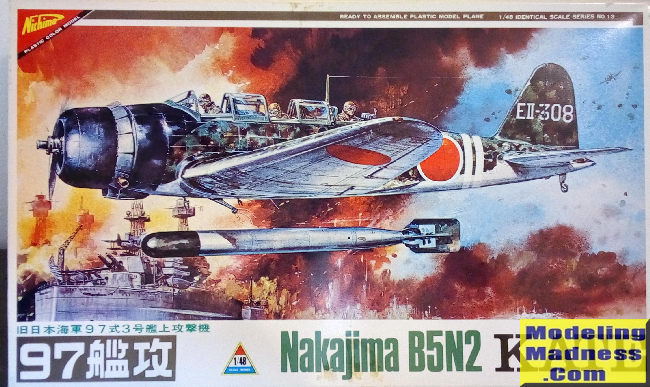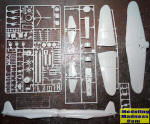
Nichimo 1/48 B5N2 Kate
| KIT #: | 4813 |
| PRICE: | €15.00 'used' |
| DECALS: | Four options |
| REVIEWER: | Spiros Pendedekas |
| NOTES: | Techmod 4 color lozenge and rib tapes |

| HISTORY |
The Nakajima B5N "Kate" was the standard carrier-based torpedo bomber of the Imperial Japanese Navy for much of World War II. Initially faster and more capable than its Allied counterparts, flown by well-trained IJN aircrews and as part of well-coordinated attacks, the B5N achieved particular successes at the battles of Pearl Harbor, Coral Sea, Midway, and Santa Cruz Islands. Though nearing obsolescence by 1941, it was nevertheless operated throughout the whole war due to the delayed development of its successor, the B6N.
| THE KIT |
Nichimo introduced this kit back in
1972, with a first reboxing during the late 80s (and a second/final one
seemingly sometime around 2000, of which very little info is available). My kit
was the late 80s reboxing, found sealed in 2005 at my usual hometown toy/hobby
shop at a bargain price.
 The
kit comes in a sturdy top opening box with a dramatic box art, portraying a Kate
releasing its famous wooden fin torpedo during the Pearl Harbor attack. Upon
opening the box, you are greeted with two 121 light gray styrene parts sealed in
two bags. The bigger parts (wing and fuselage halves) are provided separately,
whereas the rest of the parts are arranged in two sprues. Detail, together with
a good number of rivets, is engraved all over with correct depth, something
impressive considering the kit’s 1972 origins! There is an amount of flash at
all parts that will have to be cleaned up.
The
kit comes in a sturdy top opening box with a dramatic box art, portraying a Kate
releasing its famous wooden fin torpedo during the Pearl Harbor attack. Upon
opening the box, you are greeted with two 121 light gray styrene parts sealed in
two bags. The bigger parts (wing and fuselage halves) are provided separately,
whereas the rest of the parts are arranged in two sprues. Detail, together with
a good number of rivets, is engraved all over with correct depth, something
impressive considering the kit’s 1972 origins! There is an amount of flash at
all parts that will have to be cleaned up.
Cockpit detailing (a
key area at the Kate), is just average for “modern” standards, but does include
a number of parts found at the real plane (radios, the flare box etc.).
Sidewalls have a lot of detailing molded on, but it is on the shallow side.
Seats look average, as do the three provided crew figures.
The
engine is well represented, with separate cylinder rows, exhaust tubes, mounting
parts and 3-piece cowling, whereas the landing gear looks tad simplistic,
towards toy-ish. The wheel wells feature believable raised details. Ordnance is
adequately catered for, with a choice of either the famous torpedo, or one 800
kg, or one 500 kg or six 60kg bombs.
The kit offers the
“option” of motorizing the prop, by installing a (not included) Mabuchi
Mini-Baby micro motor and batteries inside the cowling and under the cockpit
respectively. Should you decide to go for this option, apart from obtaining the
micro motor, you will have to use the alternative kit-supplied cowling/battery
case and the ultra-simplified shallow cockpit floor.
The canopy is provided
as a two piece affair, with only the gunner’s part removable. It is well molded
but quite thick. Sadly it is bagged together with the sprues, meaning
potential scratches.
Instructions come in
the form of a double sided long pamphlet, featuring a type history and a parts
list. Construction is clearly spread in five main steps, each of them being a
three sub-step affair, meaning a total of 15 steps. Color callouts are given
during construction, but not for all parts. Colors are of the generic type, with
the famous “bamboo green” specified for the cockpit also present! Definitely
some (easy nowadays) research is necessary here (or, even better, get your hands
on the net-available Hasegawa Kate excellent instructions...).
Four
schemes are provided, for a radar equipped plane of 931 Squadron and for three
Carrier based planes (Zuiho, Shokaku and Akagi), the latter being commander
Fuchida’s plane during the Pearl Harbor attack. Color diagrams are really a
letdown, since only a single side view is provided for each scheme, with color
descriptions getting at places vague. Also, Commander Fuchida’s plane is not
depicted to feature a red tail, as it is generally regarded. Again, extra
research is strongly recommended.
 Decals are
well done with good color registration and minimal carrier film. Despite being
almost 40 years old, they surprisingly still look usable, only exhibiting some
carrier film yellowness (which has good chances to disappear if you tape them
from the inside of a window facing direct sunlight for a week or so).
Decals are
well done with good color registration and minimal carrier film. Despite being
almost 40 years old, they surprisingly still look usable, only exhibiting some
carrier film yellowness (which has good chances to disappear if you tape them
from the inside of a window facing direct sunlight for a week or so).
Instructions want you to first choose which version to build (motorized or not),
then proceed to engine assembly, including exhaust tubes and rear mounts, with
the cockpit coming next. After affixing the engine onto the cockpit floor, you
are supposed to trap the complete assembly between the fuselage halves, followed
by attaching the 3-piece cowling, 2-piece tailplanes, lower main wing and the
upper halves. Next step is prop, canopies and rear gun installation, with the
final step being landing gear and ordnance assembly and installation.
As a
note, my instruction leaflet was in Japanese, accompanied by a separate
“translation leaflet”. However, you may easily download a pure English
instruction leaflet from Scalemates, something I wholeheartedly recommend.
| CONCLUSIONS |
Hasegawa came in 2001
with an excellent Kate kit that supersedes the Nichimo offering in all aspects:
with frequent reissues, practically covering every version and scheme and
offered at very interesting prices, it is positively the way to go if you want
the best quarter scale Kate.
Whereas the Nichimo kit
was state of the art upon its release in 1972, it is pretty obvious that it is
now elderly in practically every respect. It is still a good kit with seemingly
correct general shape, nice engraved external details but just average cockpit
and rest of the detailing. It can still be turned into a nice model with quite a
bit of effort. It seems not to be a difficult build and the casual modeler is
expected to face no serious challenges putting it together.
This
kit is out of production, seemingly for good (though you can never know for sure
the fate of those molds), getting more and more difficult to find and with
prices gradually going ballistic due to “collectivity”. I admit that I love
putting together elderlly kits, with the particular one promising to be a
pleasant build.
December 2021
Copyright ModelingMadness.com. All rights reserved. No reproduction in part or in whole without express permission.
If you would like your product reviewed fairly and fairly quickly, please contact the editor or see other details in the Note to Contributors.